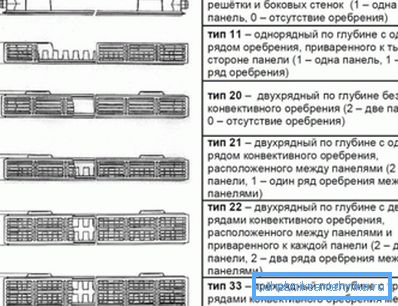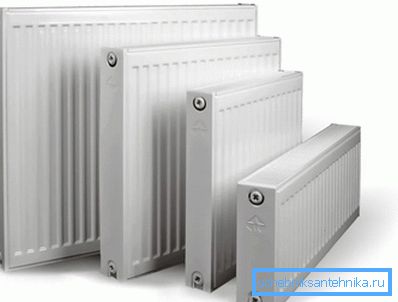Panel radiators: design features, advantages and
Classic cast iron battery does not always fit into the interior. Of course, you can cover it with a beautiful screen or close it with a curtain, but then the lion’s share of heat will simply not reach the room. The solution in this situation can be metal panel radiators - they look unusual and have excellent efficiency.

Design features
If in the case of conventional cast iron batteries, the heater is divided into separate sections, then the panel surface is solid. It is made of steel sheet, inside it is often welded to the ribs of sheet steel for more efficient heating of the room. Due to this, panel radiators have a developed side surface, which improves heat transfer.
Air vents are made in the top and bottom to ensure convection. With such a device, about 50% of the energy transferred to the room comes from thermal radiation from the side surface and about 50% comes from convection. That is, cool air is taken from below and exits through the upper holes already heated. Additional plates in the design are used to direct the air flow.

Otherwise, the principle of action of panel radiators is the same as that of conventional batteries - hot water heats the metal, and he gives thermal energy to the room. A curved steel tube passes through the heater, through which the coolant circulates.
As for the differences in the design, the panel radiators are divided into:
- models without convector panel (type 10) - are considered the most simple, there is no convector panel;
- with one steel panel (type 11) - single row fins;
- type 20 - two-row panel radiator with no internal fins;
- type 21 - also double-row, but there is also 1 row of fins inside (that is, convection is provided);
- type 22 - 2 rows and double inner ribbing;

- type 33 - 3 rows and triple inner fins.

Also, panel-type radiators can vary greatly in size (both in height and depth). This makes it possible to choose a heating device for an ordinary house, and for a room with large windows.

As for the connection of the pipes of the heating system, there are both options with side connection and with the bottom one (that is, the supply and return flow are located at the bottom of the heater).
Note! This somewhat reduces the efficiency of heating, but such panel radiators make it possible to completely hide the pipes of the heating system under the floor.

Also, a thermostat is usually included in the kit of heaters with a lower connection (it is already installed on the radiator itself). So it will be possible to regulate the battery operation in a wide range.
Read more about the features of panel radiators
Panel heaters may be slightly lower in efficiency than the best representatives of conventional radiators (for example, bimetallic). But it pays off in full with its excellent appearance, and the difference is not so significant. In addition, there are a number of features, the knowledge of which will definitely not be superfluous.
Advantages and disadvantages of steel panel radiators
Panel radiators have an impressive list of advantages:
- due to a combination of direct heat transfer and convection, the efficiency of the devices exceeds 75%, and the heat in the room is distributed more evenly;
- such devices are characterized by a reduced need for a coolant, compared with a heating system that uses cast iron batteries, the need for water is more than doubled;
Note! This feature also has a downside - since there is little water in the heating system, the boiler will have to be switched on more often to maintain the temperature in a given range. In systems of centralized heating the amount of coolant in the battery does not play a special role.
- The price of a panel radiator is lower than a vacuum or bimetallic one. This is explained by the fact that steel is much lower than copper, and the design of the heater is quite simple.
There are, of course, a couple of drawbacks, you can select:
- steel is susceptible to corrosion and in general increased requirements are placed on the quality of the coolant. In particular, the acidity should be maintained at a normal level (the pH should not exceed 9.5);

- It is recommended not to leave panel radiators for a long time without water. The fact is that steel will rust on contact with air;
- such heating devices are suitable only for systems with ordinary pressure and coolant temperature not higher than 110? С;
- they do not tolerate water hammer.
Installation of a panel radiator
The process itself is slightly different from installing a conventional battery.
The instruction consists of the following points:
- First you need to check whether the sill is not too close to the upper convection grid. If the distance is less than 7 cm, then the radiator will be worse to heat the room;

Note! Manufacturers advise to choose a device about 10% more powerful if the gaps to the floor and sill are less than 10 cm.
- then brackets are placed on the wall, they come complete with a radiator;
- Further, the radiator is placed on brackets fixed in the wall. At the same time, the packaging from the heater is not yet completely removed, but only in the places where the supply and discharge pipelines will be connected;
- if the connection is made by hand, the next step is to install the Mayevsky crane at the top of the screen and the thermostat (also comes with the radiator);

- plugs are installed.
Finally, the packaging from the heating device is removed only after the finishing work in the room is completed. Due to this, it is not necessary to clean it from dust, and the risk of scratching the surface became lower.
The most common installation errors are:
- horizontal deviation during installation. As a result, the heat output of the device becomes lower than that declared by the manufacturer;
- if the gap between the floor and the bottom of the panel radiator is too large, the air in the lower part of the room will be too cool, this will create discomfort;
- It is strictly forbidden to paint the heater with metal paints (this will worsen the heat transfer of the device), and the outlet of the air exhaust device is also painted quite often.
As for the selection of thermal power, you can simply calculate the volume of the room in cubic meters and multiply by 41. The resulting number will indicate the required power in watts for heating the room. The technical characteristics of panel radiators of heating necessarily include this parameter, so that it can be taken from the documentation on the heater.

Summarizing
Panel heaters are very different from all the usual sectional heating radiator. Such heaters look stylish and look good in any interior, and the possibility of lower connection is worth a lot.
As for which panel radiators are better, then you can advise you to choose models with internal fins, in which the transfer of thermal energy will be carried out in 2 ways.
The video in this article shows the device of the steel panel radiator.